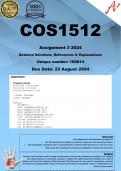Exam (elaborations)
COS1512 Assignment 3 (COMPLETE ANSWERS) 2024 (160814) - DUE 23 August 2024
- Course
- Institution
- Book
COS1512 Assignment 3 (COMPLETE ANSWERS) 2024 (160814) - DUE 23 August 2024 ;100% TRUSTED workings, explanations and solutions. for assistance Whats-App.......0.6.7..1.7.1..1.7.3.9 .......... Question 1 Consider the following structure used to keep record of a student’s scores: struct Student ...
[Show more]



